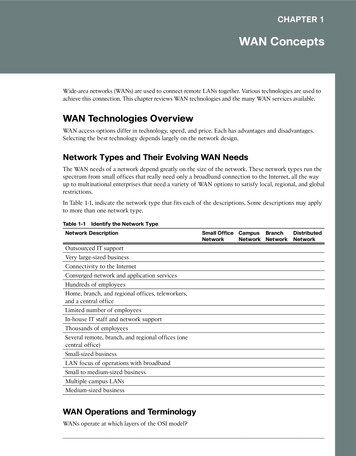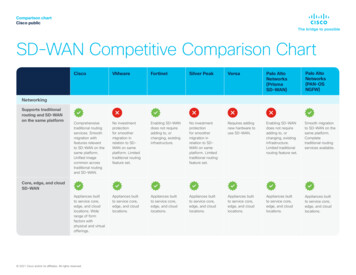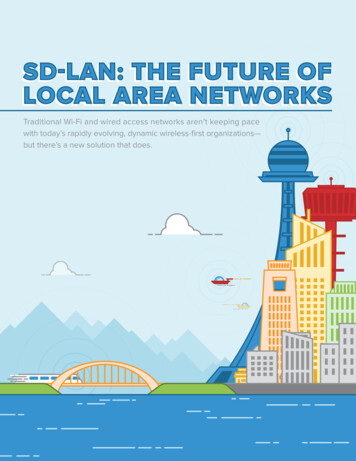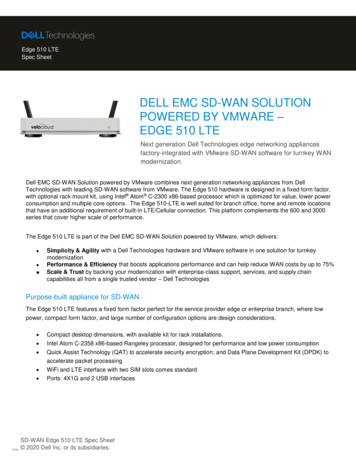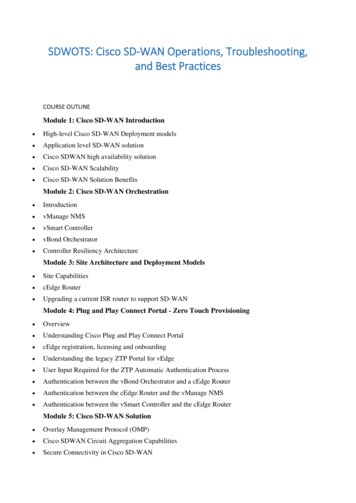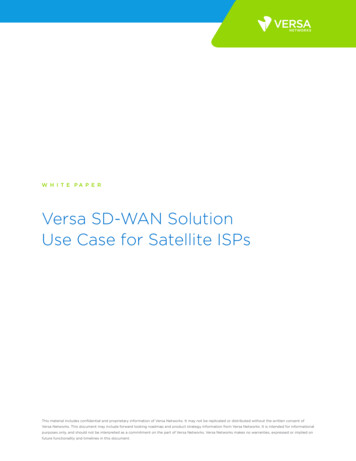
Transcription
W H I T E PA P E RVersa SD-WAN SolutionUse Case for Satellite ISPsThis material includes confidential and proprietary information of Versa Networks. It may not be replicated or distributed without the written consent ofVersa Networks. This document may include forward looking roadmap and product strategy information from Versa Networks. It is intended for informationalpurposes only, and should not be interpreted as a commitment on the part of Versa Networks. Versa Networks makes no warranties, expressed or implied onfuture functionality and timelines in this document.
Versa SD-WAN Solution Use Case for Satellite ISPsIntroductionSatellite networks offer their customers several advantages over fixed or mobilenetworks. They are easily deployed and very reliable, which makes them avery good fit for Disaster Recovery Plans (DRP) and a good fit in places whereother connectivity methods are not available. However, they have severalcharacteristics that make them harder to manage: higher latency, limited andexpensive bandwidth, asymmetric path requirements, and low space and powercapabilities, especially when working in remote sites. The Versa OperatingSystem (VOS) can help optimize these satellite networks.Versa SD-WAN provides intelligent link bonding between potentially diversetransport systems. Satellite networks may provide a customer network withits only possible transport due to terrain, or it may be used in conjunctionwith other transport networks. The VOS allows these transport systems tobe integrated into a seamless network for the end customer. The networkoperator can match applications to the path that most closely matches theneeds of the traffic patterns as well as provide resilience options.SLA Monitoring and ComplianceThe VOS Service Level Agreement Monitoring system (“SLAM”) measures manyaspects of the paths being used for the SD-WAN traffic. The system can enactpolicies based on jitter, latency, packet loss, or several other measurements tohelp decide which is the “best” path for any particular traffic. As an example,if a particular application is especially sensitive to packet loss or jitter, a policycan be put in place to send it over path 1 by default. If rain fade causes packetloss or jitter on path 1 above a certain threshold, then that application will bemoved to path 2 automatically.Versa’s SLA Monitoring capabilities can also be very helpful in hybridenvironments. For example, in some countries in the world where fiber is inits early days, optic networks have to coexist with satellite networks. Althoughfiber usually offers higher throughput rates and lower delay, it may be veryunreliable in areas where the deployment is new. VOS can automaticallyswitch from one transport network to another ensuring the connectivity isalways working.W H I T E PA P E R
Versa SD-WAN Solution Use Case for Satellite ISPsMany of our customers are concerned about if the high latency present insatellite networks can interfere in any way with Versa Control Plane protocols:IPSEC tunnels, SLA probes, or MP-BGP messages. However, Versa OperatingSystem has successfully been implemented in environments where the twoway delay between a remote branch and the controller is close to 800 ms andhas run without any ill effects.Traffic Steering Use Cases with Satellite TopologiesVersa can combine the SLA monitoring with user defined forwarding policies tocreate powerful traffic steering enhancements to satellite implementations.Hybrid Satellite PathsThe Versa solution can be used to bond satellite services from different orbits.For example, a customer may have a MEO (Mid Earth Orbit) connection formost of their low latency requirements and a GEO (Geosynchronous Orbit)connection for redundancy. Because GEO satellites orbit at a much higher orbitthan MEO satellites, they naturally incur much higher latencies than the MEOpaths. However, the properties of the electromagnetic spectrum MEO satellitesuse means that they are more affected by weather conditions.The VOS can be configured so that by default, traffic that is less sensitive tolatency will flow over the GEO connection so that the latency-sensitive traffic hasmore bandwidth available on the MEO connection. For example, data transfertraffic for update services such as Windows Update or storage sites such asDropbox can be forwarded over the GEO connection while the conferencingtraffic services such as Skype or Zoom are forwarded over the MEO path.Policies can also be set up so that in the event of an outage on one of the paths,the less important traffic is blocked to allow more critical traffic to flow.W H I T E PA P E R
Versa SD-WAN Solution Use Case for Satellite ISPsGeographical DiversificationSome frequencies used for satellite communications are more susceptible toatmospheric interference than others (“rain fade”). In the case of MEO services,some customers may implement a design where the remote terminals aregeographically separated from each other over a distance of several kilometersto allow a failover in case of signal loss at one site. Adding Versa SD-WAN tothe topology will allow the two remote terminals to be bonded together in amore intelligent way than a basic failover scenario. The rich SD-WAN policiescan allow traffic to simply loadshare across the two terminals or denote someapplications to flow over one path and the others flow over the second path.Either way, sharing the load between the available paths will help reducecongestion and potentially reduce loss and latency caused by overused paths.As mentioned earlier, policies can also be implemented to restrict non-essentialtraffic during any outage where only one of the paths is available.W H I T E PA P E R
Versa SD-WAN Solution Use Case for Satellite ISPsAsymmetric Traffic RoutingThere may be some situations where a path between two sites cannot use thesame satellite connections. Perhaps nearly all of the uplink bandwidth for link 1is provisioned for other products, but it has downlink bandwidth available. Thecustomer can get their uplink service via link 2. Link 1 will just need to haveenough bidirectional bandwidth available for control and OAM functions ofthe SD-WAN path. The Versa solution can tie link 1 and link 2 together as twounidirectional traffic paths combined for bidirectional service. The platform hasintelligent tools to apply this bidirectional routing techniques only to certainapplications or perform it solely under congestion conditions.Hybrid Satellite/LTE/WiFiAlthough most of the use cases above assume a fixed data topology, satellitenetworks are also very useful for mobile applications such as maritime oraviation. In some mobile applications, it may make sense to combine satellitecommunications with LTE, WiFi or other kinds of wireless connectivity to takeadvantage of different billing or bandwidth properties when in range of LTE orWiFi networks.W H I T E PA P E R
Versa SD-WAN Solution Use Case for Satellite ISPsFor example, VOS can be set up to prefer the shorter range transport when aship is in port, and then switch over automatically to the satellite service whenout at sea without needing to change any of the local network settings on theship. The transition from one transport to another is seamless to the end user asVOS abstraction of data plane tunnels, SLA monitoring, and failover mechanismensure a smooth transition.Several models of Versa branches have LTE and WiFi modems built directly intothe device to simplify the deployment and maintenance of the solution. Also, theuser can leverage the available Ethernet ports to connect to an external device.Optimizing Transport PathsIn addition to SLA monitoring and traffic steering profiles between branches,the VOS has several features to enhance the customer experience based ontheir traffic flows.Managing SD-WAN overheadThe modified version of VXLAN that Versa uses produces 44 bytes of overhead.Encrypting SD-WAN traffic will increase the overhead by at least 24 additionalbytes. For satellite customers using SD-WAN for applications not requiringencryption, select clear text forwarding to reduce the overhead for the enduser. This choice can be made either on a circuit level or at the forwardingprofile level if some traffic across the same path needs to be encrypted.Customers concerned about the additional control traffic can also tune theintervals of SLA probes to be less frequent than the default 2 seconds. Keep inmind that reducing SLA intervals will impact end-to-end convergence time.An additional approach to reducing SLA traffic between branches withmultiple paths is to enable data-driven SLA monitoring. Data-driven SLAmonitoring allows a path without any data traffic within a certain interval tostop sending SLA traffic. This is implemented by having an alternate pathbetween the two branches with a continuous SLA monitor so that if there issome new traffic it can take that continuously monitored path until the directpath can be reestablished.W H I T E PA P E R
Versa SD-WAN Solution Use Case for Satellite ISPsSaaS Application MonitoringSaaS Application monitoring can be added to enhance the path selectionprocess between multiple local break out (LBO) paths where the Versa SLAMis not available between branches. Customers can set up ICMP, TCP or HTTPmonitoring for a specified host and set thresholds for latency or loss on themonitoring profile. These monitoring profiles are then used to determine thebest choice between the two Internet connections.TCP OptimizationThe long latencies introduced with satellite links are a good case for TCPoptimization. TCP optimization splits the high latency TCP session into multipleTCP segments.By enabling the TCP optimization service at one or more points betweenthe client and server, both slow start convergence and loss recovery timesare dramatically improved, since the end-to-end latency is split into smaller,independent segments.Security FeaturesThe VOS solution includes the ability to integrate security features such as NextGeneration Firewall, Intrusion Prevention, and Anti-Virus features into the samedevice. This allows the power and space footprint to be reduced compared tousing separate network and security devices and also allows simpler logisticsfor a total network solution. Versa hardware can be added into a greenfieldpackage to bundle SD-WAN and security functions as a single device, or thefunctionality can be added to replace existing security devices in brownfieldSD-WAN implementation.W H I T E PA P E R
Versa SD-WAN Solution Use Case for Satellite ISPsuCPE Competitive AdvantageSatellite sites are usually allocated inremote locations where energy and spacemust be optimized. Versa uCPE capabilitiesallow the customer to implement differentnetwork functions (Firewalls, WANOptimization, Authentication, etc.) in asingle box, leveraging VNFs of differentvendors. Versa wide range of options fordeployment: White-boxes, Hypervisors,Cloud environments or Versa brandedboxes that adapt to each customer needsand requirements.AnalyticsThe Versa Analytics cluster is the central resource for SD-WAN networkreporting. It provides status and statistics for data aggregation, per-port, perapplication to monitor trends over time and report outages on the network.Satellite customers will especially find useful the latency for tenant endpointsmeasured per path and the ability to measure which applications are flowingover particular links so they can fine tune steering policies.The above chart is an example of the path usage dashboard from a remote siteto two gateways.W H I T E PA P E R
Versa SD-WAN Solution Use Case for Satellite ISPsThe above chart is an example of path SLA metrics showing that the latencyis around 130 ms to Gateway-1 over the satellite link and around 11 ms over thefiber path.The above picture shows a sample of the application performance monitoring(APM) output. This information can be used to confirm how applicationsare performing for particular transport paths as well as to see how muchbandwidth any particular application is using.W H I T E PA P E R
Versa SD-WAN Solution Use Case for Satellite ISPsWhen security features are enabled on the VOS, the Analytics dashboard willalso present audit trails for security events related to the security policiesenabled in the network. If required, the Analytics dashboard can be presentedto end customers using role-based access controls for on-demand informationspecific for that customer.Periodic reports can also be implemented to automatically email a daily healthreport to end customers.ConclusionSatellite networks provide ideal use cases for Versa SD-WAN deployments.The strengths of the Versa SLA monitoring combined with the traffic steeringpolicies allow customers to plan the best available paths for their traffic types.The powers of bundling security features with SD-WAN devices and uCPEallows customers to reduce their overall hardware footprint in deploymentswhere space and power may be at a premium. The Versa Analytics toolsprovide transparency for how well the network is running. Together, thesefeatures make a compelling justification for introducing Versa SD-WANsolutions into Satellite topologies.W H I T E PA P E R
Versa Networks, Inc, 6001 America Center Dr, 4th floor, Suite 400, San Jose, CA 95002 1 408.385.7660 info@versa-networks.com www.versa-networks.com 2021 Versa Networks, Inc. All rights reserved. Portions of Versa products are protected under Versa patents, as well as patents pending. Versa Networks and VersaOperating System are trademarks or registered trademarks of Versa Networks, Inc. All other trademarks used or mentioned herein belong to their respective owners. Part#WPSATISPUC-01.0
Managing SD-WAN overhead. The modified version of VXLAN that Versa uses produces 44 bytes of overhead. Encrypting SD-WAN traffic will increase the overhead by at least 24 additional bytes. For satellite customers using SD-WAN for applications not requiring encryption, select clear text forwarding to reduce the overhead for the end-user.


